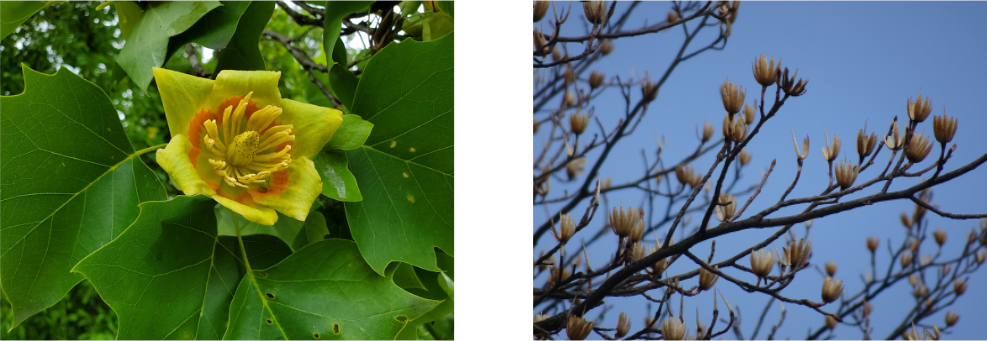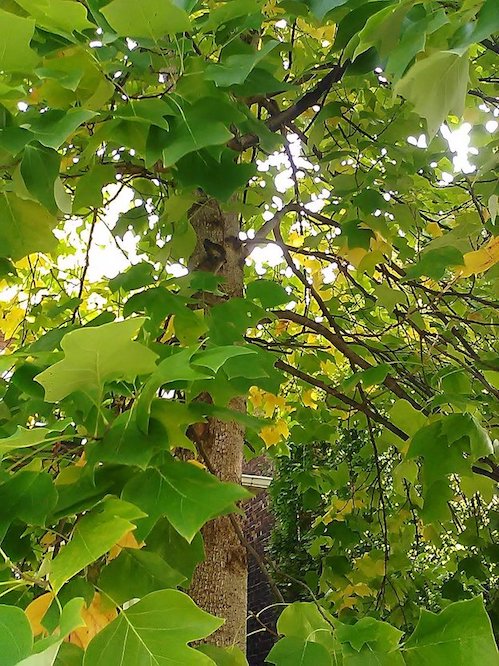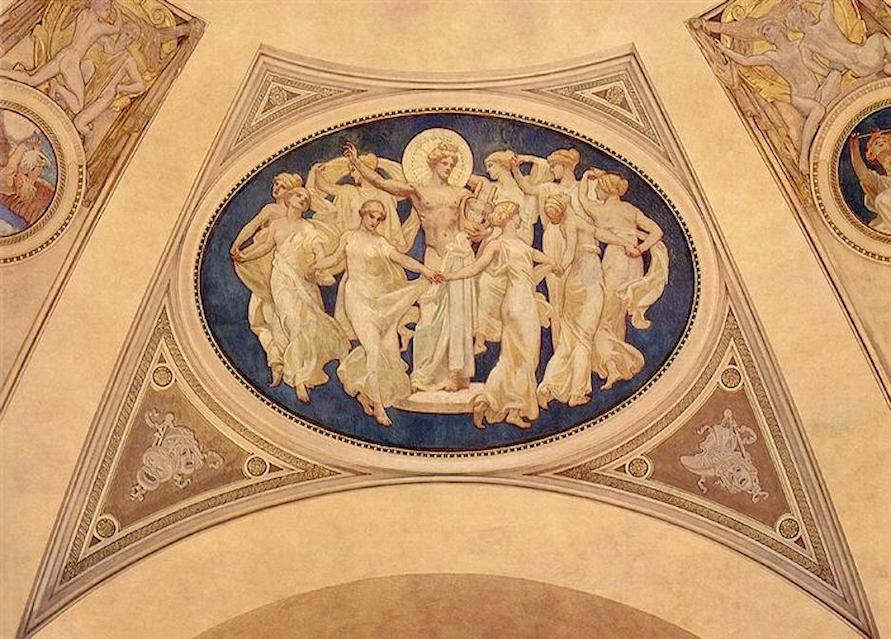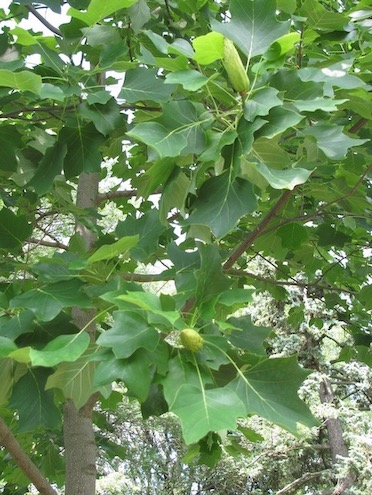
Iconic Tuliptree
Fieldnotes for June – July 2025
by Kay Broome

Tuliptrees in Vancouver in Spring (photo: Dllu)
There are few trees more elegant or handsome than this one. Tall, stately, with wide open branches that welcome the sun, Liriodendron tulipifera is splendid in all its parts. Yet a closer look shows that even tuliptree isn’t perfect: the luscious jade leaves, resembling those of maple, appear to have had their apex tips cut off. And the large tulip-like flowers – warm yellow banded in cheery orange – resemble something from an old Disney cartoon. Then there’s the fruit. The green pod when unripe, reveals tuliptree’s close ties with its cousins the magnolias, but later develops into an oddity resembling a wooden daisy.

Left, Tuliptree Flower in Summer (Photo: Andrew Eroh) Right, Fruit in Early Spring (photo: B137)
More Than Just Good Looks
These eccentricities aside, tuliptree is highly valued as an ornamental. The tree prefers moist, well drained soil, full sun and space enough to develop its open, graceful silhouette. The leaves, jade green in summer, turn butter yellow or amber in fall. In mature trees, the delightful flowers are held high out of reach of us mere mortals. The honey gathered from them is by all accounts, delightful, yet surprisingly rich and complex for such an artless blossom. Tuliptree’s greatest commercial asset however, is its smooth-grained, light coloured lumber that is soft, yet durable. This, the tallest tree in the Carolinian forest, yields long planks that are greatly prized by the building industry. While it may appear to have a haughty demeanor, tuliptree enjoys the company of many species including oak, beech, hickory, maple and hemlock.

Tuliptree, West Toronto, Early Fall (photo: Kay Broome)
That Inner Beauty
As the tuliptree so effortlessly shows, true beauty is lasting and more than skin deep. We will all lose our looks as we get older. However in this century, aging gracefully is easier than it has ever been. While some of this may be due to lucky genes, much of it is the result of access to healthy diet and lifestyle, along with prodigious advances in medicine and dentistry. And while not beautiful by most standards, many elderly people have far greater character and lead much more useful lives than those unfortunates who are obsessed with staving off the passing years. Wasting time, money and effort on endless diets, beauty aids, and countless plastic surgeries, these women, and more frequently men, eventually become grotesque parodies of themselves, resembling mannequins or lizard people. It is sad to watch them struggle to restore a youth that is neither possible nor even desirable to achieve.

Tuliptree Flower, High Park, Toronto (photo: Kay Broome)
I think we can all agree that narcissism is a profoundly modern western phenomenon. With crucial issues such as homelessness, the economy, and international events currently at play, the rest of us are fed up to here with the attention seeking, whining and corruption of many famous and wealthy performers. We soon learn that most of these people, perhaps not surprisingly, are drugs addicts and/or alcoholics, which only exacerbates their inability to connect with reality.

Narcissus at the Source, Caravaggio, circa 1597-99
On both sides of the political divide, we find famous people, some of them has-beens, many of them talentless, pontificating on things they know nothing about, usually as a ploy for attention. Living in an echo chamber, they rarely if ever, interact in any meaningful way with “ordinary” people. These celebrities have no sense of reality, no self-perception, or any idea of what is actually going on. If they were not so insufferable and tone deaf, one would be inclined to feel sorry for them.
The Muse
Today there is much discussion about the degeneration of modern music, film and the arts. To a great extent, this is due to the corporatization of everything. I believe the introduction of AI will only aggravate this. Another factor that currently stifles art is the disturbing trend of censorship and the cancellation of people whose opinions don’t fit the zeitgeist. However, I believe the root cause of the corrosion of the performing arts is that many in those fields appear to have forgotten that the artist should be a conduit for the muse – that personification of the drive that inspires us to create. While much of our creative spirit does come from within, we cannot make anything without connecting to whatever spirits guide the universe.

The Sacred Grove, Beloved of the Arts and the Muses, Pierre Puvis de Chavannes, ca. 1884-89 (Art Institute of Chicago)
Various pagan pantheons feature divine patrons of those arts and crafts that are central to their cultures. The Celts had many gods who were patrons of the creative arts. For example, music, spinning and poetry were under the purview of the Scots/Irish goddess Brigid. The Welsh Cerridwen, goddess of witchcraft, ruled inspiration. Those who drank from her cauldron were profoundly transformed. The Dagda, father to the Tuatha de Danaan, also owned a cauldron of creativity, along with a magic harp. The Celts deemed him god of knowledge and music. Among the Norse, Bragi ruled poetry, the harp and story-telling.

Idunn and Bragi by Nils Blommér, 1846
I was only able to find mention of one
deity within the Slavic pantheon who was associated with the arts – Veles, a god of cattle,
the underworld and the wilderness, apparently also ruled music. He appears to have traits not dissimilar to the Greek shepherd god Pan. In Egypt, Thoth, god of
wisdom and knowledge, was patron of learning & writing, while the moon
goddess Hathor was associated with music and dance. Ihy, a lesser known deity
and son of Hathor & Horus, held purview over poetry and the sistrum or sacred rattle.

Ihy, Egyptian God of Poetry (drawing by PharoahCrab, Wikipedia)
No pantheon however approaches the Greek for the sheer number of patrons of the arts and sciences. This may be due primarily to our current lack of knowledge regarding pagan cultures outside the Greco-Roman system. In the late Hellenic period, there were nine muses governing the arts and sciences: Melpomene (tragedy), Thalia (comedy), Calliope (epic poetry), Polyhymnia (hymns and sacred poetry), Erato (lyric choral poetry), Euterpe (flute), Terpsichore (dance and light verse), Clio (history) and Urania (astronomy and astrology). Hesiod touted them as being the daughters of Zeus and Mnemosyne (Memory), but alternate myths cite them as children of the Titan sky god, Uranus and Gaia, the earth mother. Some myths mention the muses as daughters of Apollo, but generally they are depicted as his companions, as befitted a deity associated with music, dance and poetry. Dionysus, god of the theatre was, not surprisingly, often depicted socializing with the muses, as was Athena, the goddess of wisdom. An alternate myth from Delphi cites three other muses: Nete, Mese and Hypate, who were daughters of Apollo and were deemed to rule the three chords of his instrument, the lyre. There are other variants of the Greek muses in the Hellenic world, but generally, the nine muses mentioned above are the versions familiar to most.

Apollo and the Muses, John Singer S argent, 1921, Museum of Fine Arts Boston
As previously noted, the Muses rule not only the arts, but also the sciences, and knowledge and creativity in general. Someone who genuinely loves their art or science, will place their life work above and beyond their ego. This perspective helps avoid arrogance, allowing the artist or scientist to be more open to change and to the revision and perfection of the work in progress. Having a tutelary muse, a guiding "angel" of the arts can only aid the individual in bringing forth their opus, offering it willingly to the world.
In my experience as a writer and visual
artist, when you are engaged in creative work, it is as if a fever takes over
you. You can barely keep up with the ideas and energies coming through. Although the muse is
generally personified as feminine, mine seems to be masculine. I think this is partly because the
muse is the artist’s opposite – if a man, their anima or for a woman,
their animus. The classical Greek muses were represented
as goddesses perhaps because in that era, only men were educated or allowed to be artists.

Hesiod and the Muse, Gustave Moreau, 1891 (Musée d'Orsay)
Actors and Other Performers
Because the ancient Greek theatre was in the open and the audience too far away to easily discern the stage, elaborate masks helped the actors stand out. Oddly enough for an art form held sacred to a god – Dionysus –actors in ancient Greece were generally treated with contempt. When I asked the online site Quora why this was so, someone with the moniker Assistant gave what I think is an excellent, multifaceted answer. I generalize it as follows:
Since actors customarily portray someone not themselves, they were seen in the ancient world as devious and deceptive. In addition, the ancient theatre frequently dealt with issues such as hubris and the downfall of the mighty. There may have been concern that the actors portraying these faults on stage might in some way, infect and corrupt the audience. Moreover, comedy in ancient Greece (and elsewhere throughout history) often satirized societal conventions such as religion and the upper classes. Thus, the theatre might here again be seen as a source of decadence. In ancient Greece, women were not allowed to act (or for that matter, do much of anything outside the home). As a result, male actors played female roles. As such, they were seen as beyond the pale, interestingly in a culture where homosexuality was accepted. Finally, actors merely recited but did not write the actual plays or music, therefore they were not deemed true artists.

Tragic and Comic masks from ancient Rome, influenced by Greek Theatre, Artist Unknown (Mosaic, 2nd Century CE)
Perhaps another reason for the disdain for actors was that Greece only became literate in the early Hellenic period and even then, this was true of only upper class men. As a result, the country still retained conventions common to oral societies, including prodigious memory and the importance of hospitality, truth telling and oath keeping. Perhaps the pretence of being a fictional character made actors appear to be devious and thus liars. Today we appear to have come full circle. The convention of the last 150 years or more of worshipping famous actors and musicians as if they were gods is rapidly waning. Many people now regard celebrities with disdain and distrust. We should remember however that performers are simply mortals like the rest of us. And being constantly in the public eye becomes a very great burden. Artists in turn need to appreciate that they are standing on the shoulders of the giants in their field. They must also acknowledge that much of the menial labour done by unsung workers is in fact more crucial to the basic functioning of society than their own craft. Indeed, performers today would do well to have a muse looking over their shoulder to keep them honest, humble and dedicated in their art. Perhaps entertainers can learn from tuliptree: beautiful in appearance, yet amiable with other trees; graceful of flower; and gracious with its gifts of delicious honey, ample shade and useful wood.

Tuliptree with Fruit Pods in late summer, West Toronto (photo: Kay Broome)
In the Talking Forest array, Tuliptree’s kenning or occult meaning is icon or herm. The latter is a columnar sculpture, sometimes fashioned from the trunk of a tree, portraying the bust of a deity such as Pan, Dionysus or Hermes (hence the name). These statues were devotional fertility figures, as shown by the addition of a phallus on the front of the column. The icon represents godhood – to be honoured and worshipped, and a reminder that any expression of art comes not solely from within, but from the gods, the great "out there". Although tuliptree was never native to Greece, its tall, stately trunk would make for an exemplary herm. Tuliptree’s energy is solar, reaching its apex in summer, particularly around the June solstice. Here, at the height of the year, the sun, the centre of the solar system, is at his strongest point.

Aphrodite with Herm of Dionysus, terracotta figurine, British Museum (photo: Marie-Lan Nguyen)
Upright Tuliptree in a reading represents the beloved, much like The Lovers card in the Tarot deck. The rune can indicate a romantic partner, spouse or someone cherished from afar. In any event, it generally refers to the faithful lover. Inverted, the rune suggests unrequited love, someone desired by the querent, but beyond reach. The toppled rune may speak of a union coming to an end, or dissatisfaction within a relationship. It may also warn of an unfaithful partner. In any reading showing the Tuliptree rune, the querent should pay especially close attention if either Cherry or Linden also appear in the layout, as these two keys deal with matters of the heart: Cherry with desire and passion; Linden with true or altruistic love.
The Tuliptree rune, much like the tree it represents, is symmetrical, with two wavy tines on either side of the stem, indicating a tall, stately tree. The two smaller tines located at the top of this masculine rune enclose a semi-circle representing the large graceful flower. Tuliptree appears in the Talking Forest array at the beginning of the third of six groves, or series of seven runes. This is the early adult grove, dealing with matters of romance, relationships, and the pursuit of a home and family.
Talking Forest Tuliptree Rune
